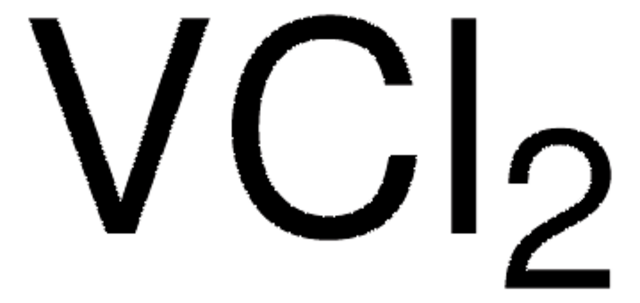762873
Chromium(II) chloride
AnhydroBeads™, −10 mesh, 99.99% trace metals basis
Synonim(y):
Chromium dichloride, Chromous chloride
About This Item
Polecane produkty
linia produktu
AnhydroBeads™
Próba
99.99% trace metals basis
Postać
beads
zanieczyszczenia
≤150.0 ppm Trace Metal Analysis
wielkość cząstki
−10 mesh
mp
824 °C (lit.)
gęstość
2.9 g/mL at 25 °C (lit.)
ciąg SMILES
Cl[Cr]Cl
InChI
1S/2ClH.Cr/h2*1H;/q;;+2/p-2
Klucz InChI
XBWRJSSJWDOUSJ-UHFFFAOYSA-L
Szukasz podobnych produktów? Odwiedź Przewodnik dotyczący porównywania produktów
Powiązane kategorie
Zastosowanie
Anhydrous chromium chloride finds applications as catalysts, chromizing ferrous metals, steel, etc. The vapor-phase co-reductions with other metal halides by hydrogen results in finely divided intermetallics with applications as structural materials or compounds with useful thermoelectric, magnetic, and oxidation-resistance properties.
Chromium chloride powder is air and water sensitive. Beads have lower surface area and pour easily.
Informacje prawne
Hasło ostrzegawcze
Warning
Zwroty wskazujące rodzaj zagrożenia
Zwroty wskazujące środki ostrożności
Klasyfikacja zagrożeń
Acute Tox. 4 Oral
Kod klasy składowania
11 - Combustible Solids
Klasa zagrożenia wodnego (WGK)
WGK 3
Temperatura zapłonu (°F)
Not applicable
Temperatura zapłonu (°C)
Not applicable
Certyfikaty analizy (CoA)
Poszukaj Certyfikaty analizy (CoA), wpisując numer partii/serii produktów. Numery serii i partii można znaleźć na etykiecie produktu po słowach „seria” lub „partia”.
Masz już ten produkt?
Dokumenty związane z niedawno zakupionymi produktami zostały zamieszczone w Bibliotece dokumentów.
Klienci oglądali również te produkty
Nasz zespół naukowców ma doświadczenie we wszystkich obszarach badań, w tym w naukach przyrodniczych, materiałoznawstwie, syntezie chemicznej, chromatografii, analityce i wielu innych dziedzinach.
Skontaktuj się z zespołem ds. pomocy technicznej













